



July 2014
The Edge of Black Holes
The Atacama Large Millimeter/submillimeter Array (ALMA) in Chile is going on the hunt for the event horizon of black holes. The event horizon is the edge of a black hole, the point of no return for objects being sucked in. To do this, an Earth-sized telescope is needed.
ALMA has been fitted with a new ultra-precise atomic clock. The clock is powered by a hydrogen maser. A maser works in the same way light is used to make lasers, but in this case utilizes the microwave part of the spectrum. This upgrade will eventually allow ALMA to sync up with a worldwide network of radio astronomy facilities and in essence form a gigantic virtual 'earth-sized' telescope. The resolving power will be thousands of times greater than that of the Hubble Space Telescope.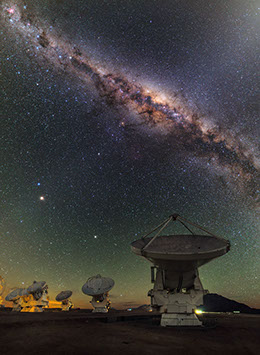
There are many applications for this network, including the study of black holes. This new telescope will have the greatest magnifying power ever achieved and will be able to look at the event horizon of the supermassive black hole at the center of the Milky Way.
The supermassive black hole at the center of the Milky Way cannot be seen in the visible spectrum. Also, gas and dust obscure any optical studies surrounding the black hole. Using the longer millimeter and submillimeter wavelengths utilized by ALMA we can look into this area. The black hole is located 26,000 light years away in the constellation Sagittarius. Its size is four million solar masses.
Credit: ESO/B. Tafeshi
Gamma-Ray Bursts
Gamma-Ray bursts are the largest explosions in the Universe. These intense bursts have been seen in distant galaxies and are usually associated with supernova explosions. One several second burst releases more energy than our Sun will release in its entire ten-billion year life.
After a Gamma-Ray burst, there is usually an afterglow created by collisions of gas and dust. But sometimes there is no afterglow. These are called dark bursts. One explanation was that in a dark burst the dust absorbed the radiation.
Now, using the Atacama Large Millimeter/submillimeter Array (ALMA), scientists have been able to map the dust and gas during a Gamma-Ray burst. It came as a complete surprise to find that there was actually a lot more dust and a lot less gas which made some Gamma-Ray bursts appear as dark bursts.
It was not expected that Gamma-Ray bursts would occur in such dusty areas. This suggests that massive stars that die as Gamma-Ray bursts change the environment before they explode.
Perhaps the massive stars in star forming regions produce enough ultraviolet radiation that breaks the bonds between atoms in the gas. This can account for the loss of gas and abundance of dust. As the massive star grows prior to exploding, it produces more uv radiation which in turn reduces the amount of gas in the region.
Further observations will be required. ALMA is getting an upgrade (see article above) and this will enable scientists to make even more precise and detailed observations of Gamma-Ray bursts and the environment surrounding them.
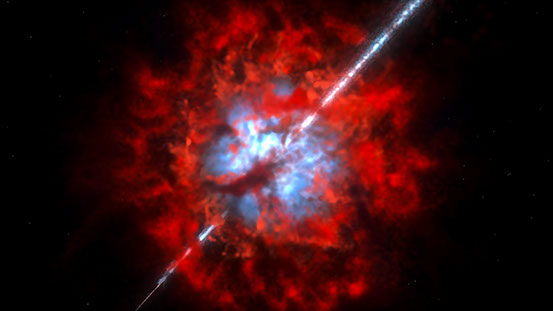
Artist's concept of a Gamma-Ray burst based on ALMA observations. Credit: NAOJ
Black Hole Shield
ESA and NASA scientists using data from the Hubble Space Telescope have found the first direct evidence of the long-predicted shielding process around black holes. At the heart of the galazy NGC 5548, researchers noticed a gas stream flowing out, blocking the X-rays.
When objects fall into a black hole they emit X-rays and ultraviolet radiation. The ultraviolet radiation creates winds that blow gas away from the black hole and save it from falling in. This could only happen if the ultraviolet radiation was somehow shielded from the X-rays.
For the first time, gas streams have been detected. These gas streams are close to the accretion disc which is formed as matter flows into the black hole. This gas stream is moving at 18 million kilometers per hour and absorbs the X-rays, thus leaving the ultraviolet radiation to create the wind that blows gas away from the black hole.
Scientists think that this gas stream may have originated from the accretion disc itself. These new results provide more insight into how supermassive black holes interact with the galaxy they are in.
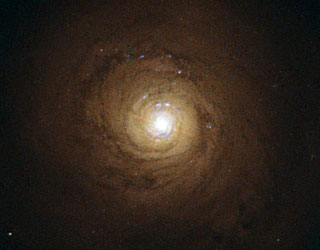
NGC 5548 -
Credit ESA/Hubble/NASA
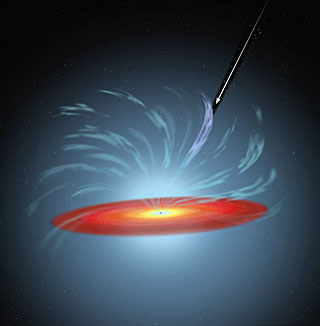
Artist Concept of gas stream flowing away from accretion disc of black hole.
Credit: NASA/ESA/A. Feild (STScI)
Visit our sponsors.
For advertising opportunities on this page and our videos, contact
Upcoming Launches
Date: July 2
Launch Vehicle: Delta II
Launch Site: Vandenberg AFB, California
Description: Orbiting Carbon Observatory to study carbon dioxide in the atmosphere to help scientists learn more about the impact of CO2 on climate change.
Date: July 10
Launch Vehicle: Antares
Launch Site: Wallops Flight Facility, Virginia
Description: Orbital 2 - Deliver cargo and supplies to the International Space Station
Date: July 23
Launch Vehicle: Soyuz
Launch Site: Baikonur Cosmodrome, Kazakhstan
Description: Deliver cargo and supplies to the International Space Station
Date: July 25
Launch Vehicle: Ariane
Launch Site: Kourou, French Guiana
Description: Automated Transfer Vehicle 5 - Deliver cargo and supplies to the International Space Station
Gum 15
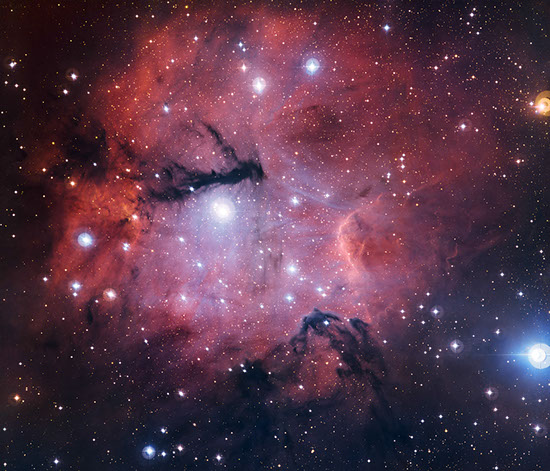
Credit: ESO
This beautiful photo is of Gum 15, a diffuse nebula located in the southern constellation Vela (the sails). It was imaged using the 2.2 metre telescope at the La Silla Observatory in Chile. It was taken as part of the ESO Cosmic Gems program which is a program designed to produce interesting, intriguing and visually attractive photos of objects using ESO (European Southern Observatory) telescopes to be used for education and public outreach.
Within the clouds of dust of Gum 15, stars are being born. What you see in this photo are infant stars. All stars, our Sun included, are made up of Hydrogen. Due to the high energy to create the stars, some of the hydrogen is ionized, stripped of its electrons. As the ionized hydrogen recaptures its electrons, it releases light in different wavelengths. This produces the reddish glow you see here, called hydrogen-alpha.
Stars are formed in an area called the HII (H-2) region. Thousands of stars will be born in this area over several million years. Eventually the stars will grow up releasing strong winds (a solar wind) and they gases of the nebula will be blown away. The nebula will cease to exist and the area will look like other regions of stars.
Happy 10th Cassini!
On June 30th, the Cassini spacecraft celebrated its 10th anniversary orbiting the ringed planet Saturn. Cassini arrived at Saturn on June 30, 2004 for a four year mission. Since 2008 NASA has granted three mission extensions. By using gravitational trajectories, precious fuel has been saved over the years. Cassini may continue through 2017 before the fuel runs out.
Cassini has seen and discovered so much in a decade around Saturn that it produced over 3000 scientific papers so far. For the 10th anniversary, the Cassini team attempted to compile a TOP-10 list of Cassini accomplishments. They noted that it was an impossible task as so much has been discovered, but they put together their favorites and here it is.
-- The Huygens probe makes first landing on a moon in the outer solar system (Titan)
-- Discovery of active, icy plumes on the Saturnian moon Enceladus
-- Saturn’s rings revealed as active and dynamic -- a laboratory for how planets form
-- Titan revealed as an Earth-like world with rain, rivers, lakes and seas
-- Studies of Saturn's great northern storm of 2010-2011
-- Studies reveal radio-wave patterns are not tied to Saturn’s interior rotation, as previously thought
-- Vertical structures in the rings imaged for the first time
-- Study of prebiotic chemistry on Titan
-- Mystery of the dual, bright-dark surface of the moon Iapetus solved
-- First complete view of the north polar hexagon and discovery of giant hurricanes at both of Saturn's poles
And there is certainly a lot more to come.
HAPPY 10th CASSINI !!!
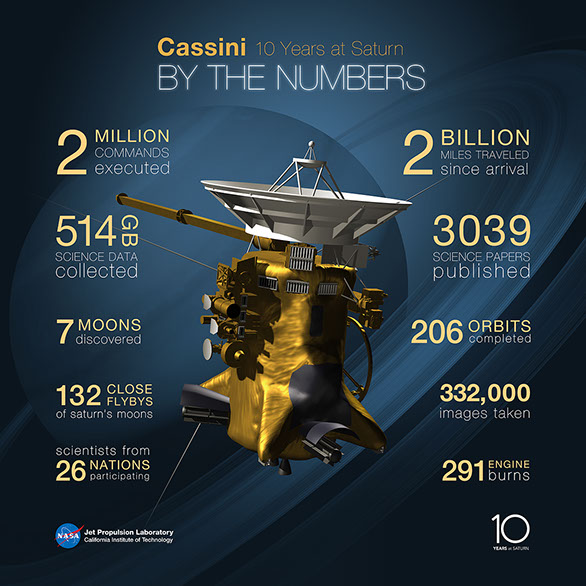
Credit: NASA/JPL-CalTech
One Year to Pluto
NASA's New Horizons spacecraft is one year away from Pluto. In July 2015, the spacecraft will perform a flyby of the dwarf-planet. Pluto is located in an area called the Kuiper Belt, a vast debris field of icy bodies left over after the formation of the solar system 4.6 billion years ago.
NASA has now called in the Hubble Space Telescope to search for other objects in the area that New Horizons might be able to visit after Pluto. It is not the first time Hubble has assisted New Horizons. Hubble has been searching for dust rings around Pluto that may be a hazard to the spacecraft. It also has looked at Pluto's features for areas to perform close-up photography of.
During its flyby of Pluto, New Horizons will also take a look at the giant moon Charon. It appears that Charon's icy surface is cracked. This indicates that there may be, or once have been, an underground ocean on Charon. The surface temperature of Pluto and Charon is around 380 degrees below zero Fahrenheit (-229 C), so water cannot be liquid at the surface.
The cracks could have been formed by gravitational tides between Pluto and Charon in their formative years. But today there are no tides. Pluto and Charon orbit each other in a stable state where they always face the same side of each other. On one side of Pluto you would never see Charon and on the other you would always see Charon.
In a years time we should unlock some of the mysteries of the remote and icy Pluto and Charon.
© 2014-2016 Ted Cook Productions LLC. - All Rights Reserved